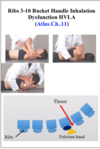Thoracic and Rib HVLA Flashcards
HVLA Supine T spine
Kirksville cronch
- Physician stand opposite the PTP
- Pt covers arms over chest with the PTP sided arm SUPERIOR
- Place THENAR eminence on the PTP with patients elbows in your upper abdomen
- Using the cephalad hand, flex the patients head and neck to localize the restrictive barriers (flexion/extension, sidebending)
Type 1: sidebend AWAY from the physician
Type 2: Sidebend toward
- Instruct the patient to inhale and exhale
- End of exhalation apply a thrust
- Reassess
What way do you induce sidebending for a Type 1 SD in the kirksville crunch
Away
What way do you induce sidebending for a Type 2 SD?
Toward the physician
Thoracic HVLA prone (type 1)
Texas Twist
- Stand on the same side of the PTP
- With the hands facing in opposite directions, place pisiform on the PTP with fingers CAUDAL and hypothenar eminence on the other PTP
- Instruct the patient to inhale and exhale
- End of exhalation apply a downward anterior HVLA thrust with a twist
- Reassess
HVLA Prone Type 2
Texas Twist
- Stand on the opposite side of the PTP
- Place thenar eminence on the PTP with fingers pointing CEPHALAD. Other hand caudal with pisiform on the opposite PTP
- Instruct the patient to inhale and exhale
- End of exhalation apply a downward anterior HVLA thrust with a twist
- Reassess
Seated Lower T spine HVLA
Patient seated with ipsilateral hand of the PTP on the neck and the contralateral hand on the other elbow; same set up as MET
- Grab biceps and engage all 3 barriers
- Place ipsilateral thenar eminence to the PTP of the dysfunctional vertebrae
- At the end of exhalation physician pulls the patient through the rotational barrier while applying a thrust anteriorly on the PTP causing an HVLA effect
- Reassess

Seated 1st rib inhalation dysfunction HVLA
J stroke
Patient is seated with the physician standing behind
- Physican places the foot on the table opposite on the side of the dysfunction and the patient drapes their arm over the physicians knee
- Physician contacts the dysfunctional rib with second MCP joint and the other hand n the patients head
- Sidebend the head towards the rib
- During exhalation gently load the first rib
- At the end of the exhalation; apply a thrust (inferiorlly, medially, and slightly anterior)
- Reassess
6.

Ribs 3-10 Bucket handle inhalation dysfunction HVLA
Patient is supine with the physician opposite the dysfunctional rib; patient crosses arms on chest with dysfunctional side on top
- Doctor places the thenar eminence of the caudal hand on the superior edge of the dysfunctional ridge
- Elevate the head into flexion
- Localize pressure at the patients elbows and have the patient breathe gently loading the barrier
- End of exhalation apply a thrust posteriorly directed above thenar eminence
- Reassess

Ribs 3-10 Bucket handle exhalation dysfunction HVLA
Patient is supine with the physician opposite to the dysfunctional rib; patient crosses arm with the side of the dysfunctional rib on the top
- Physician places thenar eminence of the caudal hand on inferior aspect of dys rib
- Other hand on neck and takes into flexion
- Physician localizes pressure through the patients elbows at the dys rinb
- end of exhalation, the doctor applies a posterior thrust that is slightly caudal to the thenar
- Reassess



